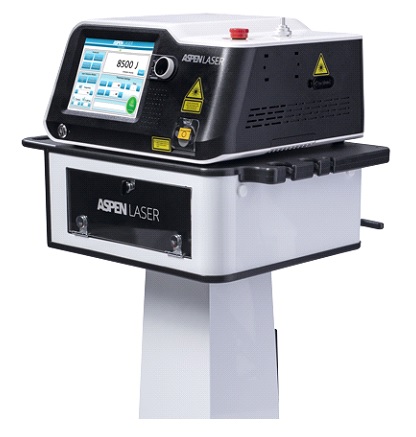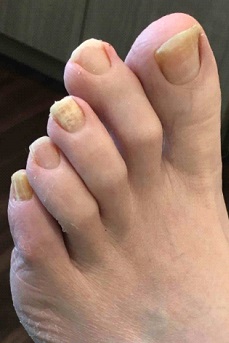
clear
Our Practice arrow_drop_downarrow_drop_up
Laser arrow_drop_downarrow_drop_up
Patient Portal

Our laser is different.
Most lasers used are CO2 lasers or yttrium-aluminum-garnet (YAG) lasers. Their wavelengths are ideal for increasing the localized temperature by producing pulses of energy that cause heat. For example, the tissue is gasified and decomposed under the nail, destroying any fungus in the surrounding tissue.
The Aspen Pinnacle laser does not work by heating the nail. This is the old method of treatment. There is no reason to suffer through the pain of a high heat treatment.
The Aspen Pinnacle laser adds a totally different mechanism to remove your fungus. The Aspen Pinnacle is a lower wavelength laser (980nm) which causes increased oxygen levels in the skin and nail leading to fungal death. Because laser treatment for toenail fungus can damage your tissue, low energy is used used for safety. As a result, multiple treatments are typically needed to eliminate all the fungal growth.
There are two major components to the treatment program. The first is the typical raising of temperature to kill the fungus. This has been replaced by the latest laser technology that produces high oxygen levels to kill fungus without heat discomfort. The second component involves the use of the actual red light laser beam to cause photo-inactivation of the fungus leading to the destruction of the genetic material of the fungus. This can only be accomplished through prolonged exposure to the laser beam with settings altered to again evenly and completely affect all layers. This is done through multiple passes over the nail. This mechanism provides a much greater amount of fungal death and the inability of the fungus to reproduce and re-infect the nail. Our laser has proven wavelengths that cause toenail fungus death and is the only FDA-cleared laser device for this type of treatment.
Yes. According to the US Department of Health and Human Services, this FDA-approved laser device produces an “… increase in clear nails in patients with onychomycosis".
Overall, laser therapy is associated with a high rate of negative cultures – meaning fungus typically doesn't grow after laser treatment. We educate our patients on appropriate hygiene and preventative measures in order to prevent recurrence.
There are excellent maintenance options to prevent recurrence of fungal infections. In very severe cases some patients have infections deep within the base and growth area of the nail and may require nail removal followed by the toenail fungus laser treatment still using the laser protocol.
No. Both commercial health plans and Medicare/Medicaid do not cover laser therapy treatment.
Laser therapy is the most expensive treatment available for toenail fungus. However, it's also the most effective and fast-acting. The cost of laser treatment for toenail fungus depends on the number of nails being treated. Certain types of laser therapy are more effective than others and typically cost more.
The cost of laser treatment includes all required sessions.
Usually 2-3 sessions are needed, typically four to eight weeks apart.
Many cases of onychomycosis are treated with topical or oral antifungals. Topical antifungals include creams, ointments, and even nail varnishes designed to prevent or treat fungal infections. By comparison, oral antifungals are much stronger but can cause systemic side effects, whereas topical antifungals are very safe.
Side effects of oral antifungal medications include elevated liver enzymes, liver failure, headaches, stomach discomfort, loss of taste, and lupus-like symptoms. Some patients are not keen on the treatment. Indeed, oral medication may need a three to six-month course, and topical antifungals can take up to a year to demonstrate results. In contrast, laser treatment for toenail fungus works relatively quicker and more effectively.
Topical treatments may cost less than $20. However, topical treatments can take longer than a year to be effective, and oral medications may take 3-12 months. A 90-day supply of terbinafine costs as little as $10 at most pharmacies.
Laser treatment for toenail fungus is a simple and generally pain-free procedure. During the session, your doctor will inspect your foot. Nail debridement where your toenails are clipped and dead skin cleared may occur prior to the procedure, if required.
The doctor performs the laser treatment. The laser will be maneuvered over the affected nails, using pulses to minimize heat on the skin.
Treatment session length typically lasts anywhere from 2-12 minutes but will depend on the target area and your condition/ number of nails treated. You may feel a slight warming sensation but should not experience any significant discomfort.
Progressively we look for these signs of improvement:The ASPEN Pinnacle Laser System features advanced technology and can deliver more energy than other therapy lasers. This additional power coupled with our optimal wavelength and treatment beam size results in deeper penetration, significantly faster treatment times and delivery of the proper therapeutic dosage. These features provide our doctors the superior ability to treat difficult conditions and ultimately provide better clinical outcomes for patients.
Our doctors will be glad to talk with you if you have questions or concerns about the laser treatment for toenail fungus. Drs. Kyle and Megan Johnson have extensive knowledge and specialized training on all aspects of its use, safety and effectiveness.







